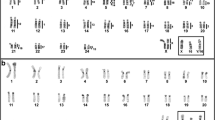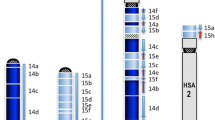Abstract
We employed fluorescence-activated chromosome sorting (FACS) to construct chromosome paint sets for the woolly monkey (Lagothrix lagotricha) and then FISH to reciprocally paint human and woolly monkey metaphases. Reciprocal chromosome painting between humans and the woolly monkey allowed us to assign subchromosomal homologies between these species. The reciprocal painting data between humans and the woolly monkey also allow a better interpretation of the chromosomal difference between humans and platyrrhines, and refine hypotheses about the genomic rearrangements that gave origin to the genome of New World monkeys. Paints of woolly monkey chromosomes were used to paint human metaphases and forty-five clear signals were detected. Paints specific to each human chromosome were used to paint woolly monkey metaphases. The 23 human paints gave 39 clear signals on the woolly monkey karyotype. The woolly monkey chromosomes painted by human paints produced 7 associations of segments homologous to human chromosomes or human chromosome segments: 2/16, 3/21, 4sol;15, 5/7, 8/18, 10/16 and 14/15. A derived translocation between segments homologous to human chromosomes 4 and 15 is a synapomorphic marker linking all Atelines. These species may also be linked by fragmentation of homologs to human 1, 4, and 15.
Similar content being viewed by others
References
Canavez FC, Moreira MA, Ladasky JJ, Pissinatti A, Parham P, Seuanez HN (1999) Molecular phylogeny of new world pri-mates (Platyrrhini) based on beta-microglobulin DNA sequences. Mol Phylogenet Evol 12: 7–82.
Cavagna PAM, Stanyon R (2000) Genomic homology of the domestic ferret with cat and humans. Mamm Genome (in press).
Chu EHY, Bender MA (1962) Cytogenetics and evolution of primates. Ann NY Acad Sci 102: 25–266.
Clemente IC, Garcia Caldes M, Ponsa M, Egozcue J (1987) High-resolution chromosome banding studies in Cebus apella, Cebus albifrons and Lagothrix lagotricha: Compari-son with the human karyotype. Am J Primatol 13: 2–36.
Consigliere S, Stanyon R, Koehler U, Agoramoorthy G, Wienberg J (1996) Chromosome painting defines genomic rearrangements between red howler monkey subspecies. Chromosome Res 4: 26–270.
Consigliere S, Stanyon R, Koehler U, Arnold N, Wienberg J (1998) In situ hybridization (FISH) maps chromosomal homologies between Alouatta belzebul (Platyrrhini, Cebidae) and other primates and reveals extensive interchromosomal rearrangements between howler monkey genomes. Am J Primatol 46: 11–133.
Dutrillaux B, Couturier J, Fosse AM (1980) The use of high resolution banding in comparative cytogenetics: comparison between man and Lagothrix lagotricha (Cebidae). Cytogenet Cell Genet 27: 4–51.
Dutrillaux B, Couturier J, Viegas-Pe¨ quignot E (1986) Evolution chromosomique des Platyrrhiniens. Mammalia 50: 5–81.
Egozcue J, Perkins EM (1970) The chromosomes of Humboldt's woolly monkey (Lagothrix lagotricha, Humboldt 1812). Folia Primatol 12: 7–80.
Finelli P, Stanyon R, Plesker R, Ferguson-Smith MA, O'Brien PC, Wienberg J (1999) Reciprocal chromosome painting shows that the great difference in diploid number between human and African green monkey is mostly due to non-Robertsonian fissions. Mamm Genome 10: 71–718.
Ford S (1986) Systematics of the New World monkeys. In: Swindler D, Erwin J eds. Comparative Primate Biology. New York: AR Liss, pp 7–135.
Garcia F, Nogues C, Ponsa M, Ruiz Herrera A, Egozcue J, Garcia Caldes M (2000) Chromosomal homologies between humans and Cebus apella (Primates) revealed by ZOO-FISH. Mamm Genome 11: 39–401.
Garcia M, Miro R, Ponsa M, Egozcue J (1980) Banding patterns of the chromosomes of a specimen of Lagothrix lagotricha cana. Genetica 54: 18–184.
Horovitz I, Zardoya R, Meyer A (1998) Platyrrhine systematics: a simultaneous analysis of molecular and morphological data. Am J Phys Anthropol 106: 26–281.
Hugot JP (1998) Phylogeny of neotropical monkeys: the interplay of morphological, molecular, and parasitological data. Mol Phylogenet Evol 9: 40–413.
Kay RF (1990) The phyletic relationships of extant and fossil Pitheciinae (Platyrrhini, Anthropoidea). J Hum Evol 4: 44–456.
Kinzey WG (1997) Brachyteles. In: Kinzey WG ed. NewWorld Primates: Ecology, Evolution and Behavior. New York: Aldine de Gruyter, pp 20–207.
Meireles CM, Czelusniak J, Schneider MP et al. (1999) Molecular phylogeny of ateline new world monkeys (Platyrrhini, atelinae) based on gamma-globin gene sequences: evidence that brachyteles is the sister group of lagothrix. Mol Phylogenet Evol 12: 1–30.
Morescalchi MA, Schempp W, Consigliere S, Bigoni F, Wienberg J, Stanyon R (1997) Mapping chromosomal homology between humans and the black-handed spider monkey by £uorescence in situ hybridization. Chromosome Res 5: 52–536.
MÏller S, O'Brien PC, Ferguson Smith MA, Wienberg J (1997) Reciprocal chromosome painting between human and prosimians (Eulemur macaco macaco and E. fulvus mayottensis). Cytogenet Cell Genet 78: 26–271.
MÏller S, Stanyon R, Finelli P, Archidiacono N, Wienberg J (2000) Molecular cytogenetic dissection of human chromosomes 3 and 21 evolution. Proc Natl Acad Sci USA 97: 20–211.
MÏller S, Stanyon R, O'Brien PC, Ferguson-Smith MA, Plesker R, Wienberg J (1999) Defining the ancestral karyotype of all primates by multidirectional chromosome painting between tree shrews, lemurs and humans. Chromosoma 108: 39–400.
Murphy WJ, Sun S, Chen Z et al. (2000) A radiation hybrid map of the cat genome: implications for comparative mapping [In Process Citation]. Genome Res 10: 69–702.
Rabbitts P, Impey H, Heppell Parton A et al. (1995) Chromosome specific paints from a high resolution £ow karyotype of the mouse. Nat Genet 9: 36–375.
Richard F, Lombard M, Dutrillaux B (1996) ZOO-FISH suggests a complete homology between human and capuchin monkey (Platyrrhini) euchromatin. Genomics 36: 41–423.
Richard F, Lombard M, Dutrillaux B (2000) Phylogenetic origin of human chromosomes 7, 16, and 19 and their homologs in placental mammals. Genome Res 10: 64–651.
Rosenberger AL (1984) Fossil NewWorld monkeys dispute the molecular clock. J Hum Evol 13: 73–742.
Schneider H (2000) The current status of the New World monkey phylogeny. Acad Bras Cienc 72: 16–172.
Sherlock JK, Griffin DK, Delhanty JD, Parrington JM (1996) Homologies between human and marmoset (Callithrix jacchus) chromosomes revealed by comparative chromosome painting. Genomics 33: 21–219.
Stanyon R, Consigliere S, Muller S, Morescalchi A, Neusser M, Wienberg J (2000) Fluorescence in situ hybridization (FISH) maps chromosomal homologies between the dusky titi and squirrel monkey. Am J Primatol 50: 9–107.
Stanyon R, Yang F, Cavagna P et al. (1999) Reciprocal chromosome painting shows that genomic rearrangement between rat and mouse proceeds ten times faster than between humans and cats. Cytogenet Cell Genet 84: 15–155.
Telenius H, Carter NP, Bebb CE, Nordenskjold M, Ponder BAJ, Tunnacliffe A (1992) Degenerate oligonucleotide-primed PCR: General amplification of target DNA by a single degenerate primer. Genomics 13: 71–725.
Viegas Pequignot E, Koiffmann CP, Dutrillaux B (1985) Chromosomal phylogeny of Lagothrix, Brachyteles, and Cacajao. Cytogenet Cell Genet 39: 9–104.
vonDornum M, Ruvolo M(1999) Phylogenetic relationships of the New World monkeys (Primates, platyrrhini) based on nuclear G6PD DNA sequences. Mol Phylogenet Evol 11: 45–476.
Wienberg J, Jauch A, Stanyon R, Cremer T (1990) Molecular cytotaxonomy of primates by chromosomal in situ suppression hybridization. Genomics 8: 34–350.
Wienberg J, Stanyon R (1997) Comparative painting of mammalian chromosomes. Curr Opin Genet Dev 7: 78–791.
Wienberg J, Stanyon R (1998) Comparative chromosome painting of primate genomes. ILAR J 39: 7–91.
Wienberg J, Stanyon R, Jauch A, Cremer T (1992) Homologies in human and Macaca fuscata chromosomes revealed by in situ suppression hybridization with human chromosome specific DNA libraries. Chromosoma 101: 26–270.
Rights and permissions
About this article
Cite this article
Stanyon, R., Consigliere, S., Bigoni, F. et al. Reciprocal chromosome painting between a New World primate, the woolly monkey, and humans. Chromosome Res 9, 97–106 (2001). https://doi.org/10.1023/A:1009274802086
Issue Date:
DOI: https://doi.org/10.1023/A:1009274802086




